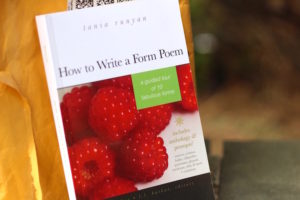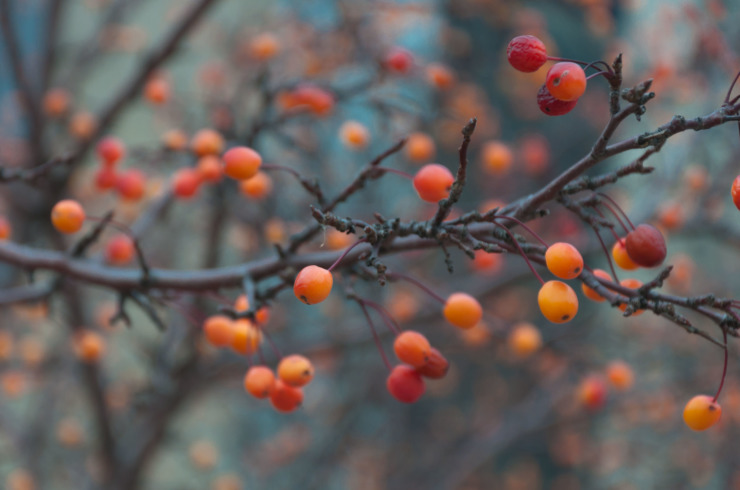Forms are how I was introduced to poetry, and I bet you were too. I still have my copy of Pegasus, a little book our fourth- and fifth-grade language arts class produced, a collection of eight different forms, plus Christmas poems (because why not). Here’s my Christmas tanka:
Snowflakes drift to ground
The young trees shake and quiver
With wonderful thoughts
Of comfortable lit houses
And packages beneath them
I still remember writing this poem. The form was not a lock — chaining me somewhere I did not want to go — but a key, transforming a Wyoming memory into a poem. That is the freedom form provides.

Form brings a freedom you didn’t know you lacked.”
Freedom is a word that’s similar to the word generosity. We write because we want to share, to be generous with words and ideas. But sometimes we can’t get the poem we’re writing to gel, no matter how many times we erase and try again. Using a form can often free us to be the generous writers we hope to be.
Runyan uses a travel theme to not only explain what each of the ten forms are, but also to share her own journey learning to write each one. So we learn that the villanelle is good to try on short plane flights. Or that found poetry is a cure for writer’s block. Or that an ode can be an outlet for writing about obsessions.
Perhaps my favorite part of Runyan’s form poetry journey (thus far, since I haven’t yet finished the book) is her saga with sonnets.
Writing that first sonnet is about survival.”
She goes on to say that sonnets were not her thing, until she discovered that the form’s “limitations are my freedom.” She decides to write fifteen sonnets, one for each of the prime numbers of her life, and each sonnet is epistolary, addressed to herself at that age. It forces her to write about ages she had ignored in previous poems. Here’s one of them.
Sonnet for 13
To the one I love, whose cowlicks grew in waves
so that your bangs resembled handlebars
set atop a face you could not save:
salmon glasses, braces, acne scars.
I have a job for you. Grab a mirror
and stare into the deepest, widest pore.
Gaze into the sheen of oil. Draw near
to the hole that opens like a door
to everything you hate about yourself.
Then tie a bikini around your cardboard chest
and run into summer’s indifferent wealth
where once you hid with the dispossessed.
Be ugly and free in the eucalyptus.
Toss back your hair and call it delicious.
—Tania Runyan
I have been spending much of this school year playing with sonnets, and now (shhh!) I think they’re kinda fun. One challenge I enjoy giving myself is when I stumble upon a sonnet, either at Every Day Poems, or on a poetry podcast, or as one of the dozen in How to Write a Form Poem, I try to imitate it.
First I journal about the poem, writing down its rhyme scheme and anything else that catches my eye, and then I write my own poem in the same style. Because I’m working within limitations, a free-verse poem that might have resembled a piece of prose with random line breaks now has a bit of heft.
At the end of each chapter of How to Write a Form Poem is a way to Go the Extra Mile. For the sonnet chapter, that includes moving from a Shakespearean to a Petrarchan and a Spenserian, or by going big with a sonnet sequence or a crown of sonnets. The end of the book includes more examples of each form, and each includes a writing prompt.
I’ve been working on a group of sonnets in March, but I haven’t gotten the hang of iambic pentameter — something Runyan suggests can be internalized with The Sonnet Stroll, the da-DUM, da-DUM, da-DUM, da-DUM, da-DUM of walking. So this week, while taking my dogs for their constitutional, I brought along a recording of myself reading the Shakespearean sonnets in the book: da-DUM, da-DUM, da-DUM, da-DUM, da-DUM. And then I picked up my pencil and wrote again.
March Pages
Poetry
Poems to See By: A Comic Artist Interprets Great Poetry, by Julian Peters (a Tweetspeak recommendation, excellent for poetry journaling)
Middle Grade and YA
Harry Potter and the Deathly Hallows, by J.K. Rowling (thus ends a five-year journey with the Harry Potter and the Sacred Text podcast)
Dry, by Neal Shusterman and Jarrod Shusterman (Join us for a Poetic Earth Month-themed Children’s Book Club next Friday, April 9!)
Grownups
Learning from Henri Nouwen & Vincent Van Gogh: A Portrait of the Compassionate Life, by Carol A. Berry
The Guest List, by Lucy Foley (Definitely buy the audio version! How else will you know how to pronounce the name Aoife?)
Wintering, by Katherine May (another excellent journaling opportunity)
Open and Unafraid: The Psalms as a Guide to Life, by W. David O. Taylor
Saga of the Volsungs, by a 13th century Icelandic bard
Made Progress
All Creatures Great and Small, by James Herriot
How to Write a Form Poem, by Tania Runyan
Your Turn
1. What types of form poems do you remember writing in school?
2. Is there a modern take on an old form you have enjoyed, either in Runyan’s book or at another favorite poetry place?
3. Share your March pages. Sliced, started, and abandoned are all fair game.
Photo by bradhoc, Creative Commons, via Flickr. Post by Megan Willome.
Browse more Reading Generously
“Megan Willome’s The Joy of Poetry is not a long book, but it took me longer to read than I expected, because I kept stopping to savor poems and passages, to make note of books mentioned, and to compare Willome’s journey into poetry to my own. The book is many things. An unpretentious, funny, and poignant memoir. A defense of poetry, a response to literature that has touched her life, and a manual on how to write poetry. It’s also the story of a daughter who loses her mother to cancer. The author links these things into a narrative much like that of a novel. I loved this book. As soon as I finished, I began reading it again.”
—David Lee Garrison, author of Playing Bach in the D. C. Metro
- Perspective: The Two, The Only: Calvin and Hobbes - December 16, 2022
- Children’s Book Club: A Very Haunted Christmas - December 9, 2022
- By Heart: ‘The night is darkening round me’ by Emily Brontë - December 2, 2022


Glynn says
Lately, I’ve been attracted to sonnets. No particular reason, but there’s something calming about them and other form poems. I suppose it could be a reaction to opening the daily newspaper — searching for order amid the chaos.
March reading:
Fiction
The Moon is Down by John Steinbeck
The Return of the King by J.R.R. Tolkien
Gerta by Katerina Tuckova
The Notorious Adventures of Nutt the Nefarious by Seth Lewis
Paris Time Capsule by Ella Carey
Your Story, My Story by Connie Palmen
23 by Seyfettin Steele
Dreams for Stones by Ann Warner
Shakespeare plays
Richard III
Julius Caesar
Two Gentlemen of Verona
King John
Mystery
Death Comes But Twice by David Field
Eight Ghosts by English Heritage
The Tutankhamen Murder by Roy Lewis
Confronting the Invisible by David Field
Poetry
My Father’s Face by Chandra Gurung
Poems by Osip Mandelstam
The Gift of Life: An Epic in Verse by Amanda Hall
Faith
C.S. Lewis: Pre-Evangelism for a Post-Christian World by Brian Williams
Non-fiction
Prairie Spring by Pete Dunne
One thing not reflected in the March list is about six readings /editings of the new novel manuscript. It’s the intense part of the writing process for me.
Megan Willome says
You’re absolutely right—that should count as part of your reading.
Thanks for always sharing your list!
L.L. Barkat says
I can’t believe you still have that tanka! (And, hey, it’s pretty good for a school poem 🙂 ).
Also, I loved this: “Using a form can often free us to be the generous writers we hope to be.” I think maybe part of how it does that is by helping us work on less at a time. Maybe it feels like more, but it’s not. The form is, as one of the poet interviews coming up will say, acting as a co-creator. And that means we’re in partnership, with the form doing part of the work. Maybe that partnership itself is also somehow part of the generosity.
Megan Willome says
I like the idea of form as co-creator. That was certainly true for me when I used Tania’s book over the weekend, to try a rondelet (part of the Go The Extra Mile in the rondeau chapter).